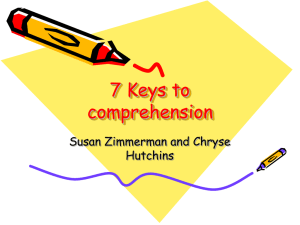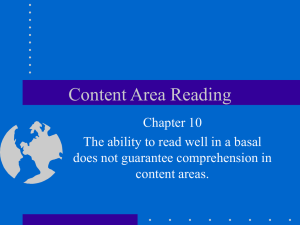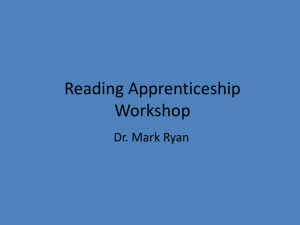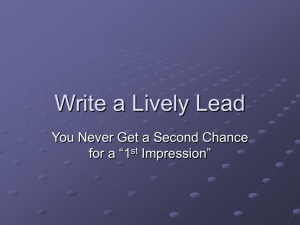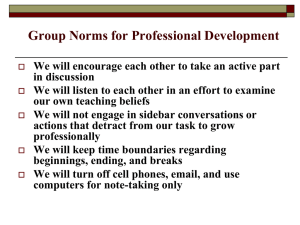Presentation
advertisement
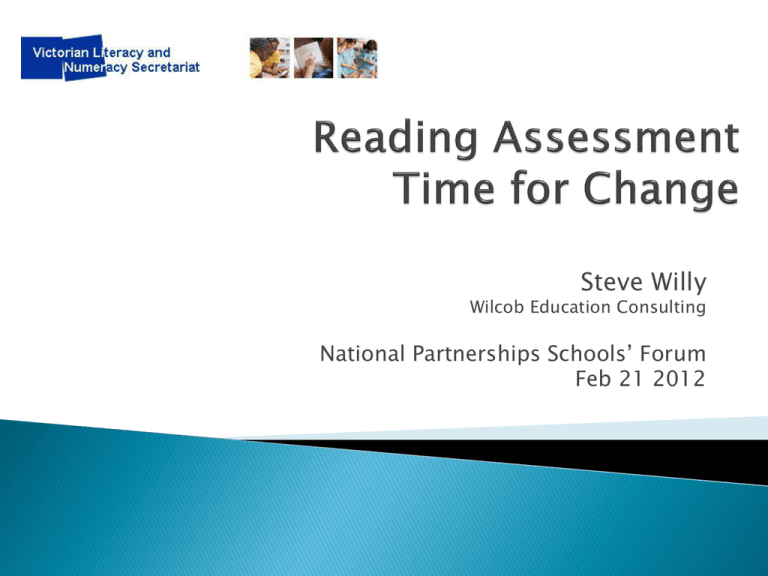
Steve Willy Wilcob Education Consulting National Partnerships Schools’ Forum Feb 21 2012 1. Reading assessment should be informed by a deep understanding of what we now know about the reading process 2. There needs to be some serious evaluation of the efficacy of the assessments we are using. 3. There should be a dynamic relationship between assessment and instruction on an ongoing basis (formative assessment). ef·fi·ca·cy Noun [ef-i-kuh-see] The capacity to produce the intended result. Source: 1. Reading assessment should be informed by a deep understanding of what we now know about the reading process. How we conceptualise “reading” is a critical consideration when we decide on how to assess and how to nurture our students as readers. Our conception of reading has changed ... so must our assessment of reading!! Verbatim recall of recently read text Effective identification of details and main ideas Employment of prior knowledge to construct meaning Critical appraisal of meaning Comprehend and use constructed meaning of texts (including multimedia and internet) to conduct related tasks and responses Reading is the construction of meaning from text. It includes the use of skills, strategies and prior knowledge to understand and critically appraise what is read. Reading is supported by reader motivation and positive affect. When verbatim recall was considered accomplished reading ◦ then matching reader spoken or written recall with the original text was effective assessment. When good reading was understood to be the identification of main ideas and supporting details ◦ then correctly selecting main ideas and details from competing multiple choices was suitable assessment. If, however, a good reader constructs meaning and uses the constructed meaning in a task – ◦ then assessment should reflect student achievement in related terms. Remember important information and carry it forward Solve Words Adjust Use a range of strategies to read and understand words Critique Think critically about the text Systems of Strategic Actions Notice aspects of the writer’s craft and text Think about structure what the writer means but has not stated Analyse Infer VELS Take action in flexible ways to solve problems or fit purpose and genre Think about what may happen next Adjust present understanding to accommodate new knowledge Synthesise Predict 12 2. There needs to be some serious evaluation of the efficacy of the assessments we are using. Contrasts between how readers think and typical assessment practices New views of the reading process tell us that . . . Yet when we assess reading comprehension, we . . . Prior knowledge is an important determinant of reading comprehension. Mask any relationship between prior knowledge and reading comprehension by using lots of short passages on lots of topics. A complete story or text has structural and topical integrity. Use short texts that seldom approximate the structural and topical integrity of an authentic text. Inference is an essential part of the process of comprehending units as small as sentences. Predominantly rely on literal comprehension text items. The diversity in prior knowledge across individuals as well as the varied causal relations in human experiences invites many possible inferences to fit a text or question. The ability to vary reading strategies to fit the text and the situation is a hallmark of an expert reader. The ability to synthesise information from various parts of the text and different texts is a hallmark of an expert reader. Use multiple-choice items with only one correct answer, even when many of the responses might, under certain conditions, be plausible. Seldom assess how and when students vary the strategies they use during normal reading, studying, or when the going gets tough. Rarely go beyond finding the main idea of a paragraph or passage. The ability to ask good questions of text, as well as to answer them, is a hallmark of an expert reader. Seldom ask students to create or select questions about a selection they may have just read. All aspects of a reader’s experience, including habits that arise from school and home, influence reading comprehension. Reading involves the orchestration of many skills that complement one another in a variety of ways. Rarely view information on reading habits and attitudes as being as important information about performance. Skilled readers are fluent; their word identification is sufficiently automatic to allow most cognitive resources to be used for comprehension. Learning from text involves the restructuring, application and flexible use of knowledge in new situations. Rarely consider fluency as an index of skilled reading. Use tests that fragment reading into isolated skills and report performance on each. Often ask readers to respond to the text’s declarative knowledge rather than to apply it to near and far transfer tasks. New views of the reading process tell us that . . . Yet when we assess reading comprehension, we . . . Prior knowledge is an important determinant of reading comprehension. Mask any relationship between prior knowledge and reading comprehension by using lots of short passages on lots of topics. A complete story or text has Use short texts that seldom structural and topical integrity. approximate the structural and topical integrity of an authentic text. Inference is an essential for comprehending units as small as sentences. Predominantly rely on literal comprehension text items. New views of the reading process tell us that . . . Yet when we assess reading comprehension, we . . . The diversity in prior knowledge across individuals as well as the varied causal relations in human experiences invites many possible inferences to fit a text or question. Use multiple-choice items with only one correct answer, even when many of the responses might, under certain conditions, be plausible. The ability to synthesise information from Rarely go beyond finding the main idea of a various parts of the text and different texts paragraph or passage. is a hallmark of an expert reader. The ability to vary reading strategies to fit Seldom assess how and when students vary the text and the situation is a hallmark of the strategies they use during normal an expert reader. reading, studying or when the going gets tough. New views of the reading process tell us that . . . Yet when we assess reading comprehension, we . . . The ability to ask good questions of Seldom ask students to create or text, as well as to answer them, is a select questions about a selection hallmark of an expert reader. they may have just read. All aspects of a reader’s experience, including habits that arise from school and home, influence reading comprehension. Rarely view information on reading habits and attitudes as being as important information about performance. Reading involves the orchestration Use tests that fragment reading into of many skills that complement one isolated skills and report another in a variety of ways. performance on each. New views of the reading process tell us that . . . Yet when we assess reading comprehension, we . . . Skilled readers are fluent; their Rarely consider fluency as an word identification is index of skilled reading. sufficiently automatic to allow most cognitive resources to be used for comprehension. Learning from text involves the restructuring, application, and flexible use of knowledge in new situations. Often ask readers to respond to the text’s declarative knowledge rather than to apply it to near and far transfer tasks. By Kate Chopin 1. “Her fancy was running riot along those days ahead of her.” This sentence shows that Mrs Mallard was a) b) c) d) 2. What did Mrs Mallard feel when she first heard of her husband’s death? a) b) c) d) 3. not sure of what to do next. afraid to go downstairs. sad about the death of her husband. looking forward to the future. Freedom Grief Afraid Strange What is this story mainly about? a) b) c) d) Train travel can sometimes be dangerous. Sometimes people are repressed in relationships. Death often is sudden and unexpected. Sometimes tragedy has unexpected consequences. What kind of food do rabbits enjoy the most? Potatoes Lettuce Oranges Celery First Grade Takes a Test, Miriam Cohen. 1980. Bantam Doubleday Dell Books for Young Readers. 3. There should be a dynamic relationship between assessment and instruction on an ongoing basis (formative assessment) The assessment should look like the instruction – NOT the other way around. Dylan William John Hattie ◦ Formative Evaluation – 3rd out of 134 approaches influencing student achievement. ◦ Feedback – 10th Purpose To reduce the discrepancies between current understanding/performance and a desired goal. This discrepancy can be reduced by: Teachers Providing appropriate, challenging and specific goals OR Assisting students to reach goals through formative assessment systems Students Increased effort and employment of more effective strategies OR Abandoning, blurring or lowering the goals Effective Formative assessment systems answer three questions: Feed-Up Where am I going? Feedback How am I doing? Feed-Forward Where am I going next? Hattie, J. Visible Learning (2009) Formative Summative Everyday instructional practice At the end of instruction Instant feedback for teacher and student Feedback often delayed Informs adjustments to teaching and student practice Informs future curriculum Focuses on the task/understanding Focuses on student achievement at a specific moment Feedback for improving student achievement Informs future placements and directions for individual students Feedback to teachers to support planning and collaboration (internal accountability) Supports external accountability measures We need to develop assessments that measure the complexity of student achievement. Gather information about what students are doing when they read. ◦ It is impossible for teachers to know what students are thinking when they read, unless they tell us through conversation or writing. Remember important information and carry it forward Solve Words Adjust Use a range of strategies to read and understand words Critique Think critically about the text Notice aspects of the writer’s craft and text structure Analyse Systems of Strategic Actions Take action in flexible ways to solve problems or fit purpose and genre Think about what may happen next Think aboutAdjust what the present understanding writer means but to accommodate has not new knowledge stated Infer Synthesise Predict Readers experience empathy... Readers experience memorable emotional response... Readers experience the aesthetic Readers ponder new facets or twists... Readers generate new ideas and imagine new possibilities... Readers focus, advocate and evaluate... Readers recognise patterns and symbols... Readers extrapolate from details in the text... Boar Out There by Cynthia Rylandt Readers experience empathy... Readers experience memorable emotional response... Readers experience the aesthetic Readers ponder new facets or twists... Readers generate new ideas and imagine new possibilities... Readers focus, advocate and evaluate... Readers recognise patterns and symbols... Readers extrapolate from details in the text... But when she leans on the fence, looking into the trees, her eyes are full and she leaves wet patches on the splintery wood. She is sorry for the torn ears of the boar and sorry that he has no golden horn. I can see how Jenny would feel sad about the boar. She thought he was majestic and powerful and he turned out to be bloody, alone and frightened. And now the pounding was horrible, too loud and confusing for Jenny. Horrible. She stood stiff with wet eyes and knew she could always pray, but for some reason didn’t. He came through the trees so fast that she had no time to scream or run. And he was there before her. Jenny is now in a terrible situation. I wish she had not gone there. I think the boar might injure her, or even worse. I wish she had not taken such a risk. She imagined him running heavily through the trees, ignoring the sharp thorns and briars that raked his back and sprang away trembling. The author creates a powerful image with this sentence. One can easily visualise the thorns as they “raked his back”. Jenny is imagining the power and majesty of the boar as the thorns “sprang away trembling” and the reader is also invited into the image. High in the trees a bluejay yelled, and, suddenly, it was over. Jenny stood like a rock as the boar wildly flung his head and in terror bolted past her. Past her ... This is incredible. It is the boar who is afraid. Jenny must be shocked at this. One hot summer day she went to find the boar. No one in Glen Morgan had ever gone past the old black Dodge and beyond, as far as she knew. But the boar was there somewhere, between those awful trees, and his dark green eyes waited for someone. Jenny felt it was she. It takes a particular kind of person to do what Jenny did. Some people take risks unthinkingly and others overcome their fears to pursue something that they want or think is important. Still others would never consider taking a risk like that, even if they were fascinated by what they might find. If this all goes wrong it could change Jenny. One hot summer day she went to find the boar. No one in Glen Morgan had ever gone past the old black Dodge and beyond, as far as she knew. But the boar was there somewhere, between those awful trees, and his dark green eyes waited for someone. Jenny felt that it was she. Jenny knows about the about the general reputation of the boar in Glen Morgan but I can understand her wanting to explore and learn about him for herself. She is so fascinated by the boar that she is curiously drawn to him. High in the trees a bluejay yelled, and, suddenly, it was over. Jenny stood like a rock as the boar wildly flung his head and in terror bolted past her. Past her... Quite suddenly the author has created a significant change in the story. Up to this moment the boar has been terrifying, but in reality it is the boar that is terrified. Most of the story is about Jenny fearing and being fascinated by the boar, but now, just at the end, it all changes. This is a key turning point in the story. But mostly she is sorry that he lives in fear of bluejays and little girls, when everyone in Glen Morgan lives in fear of him. I think Cynthia Rylandt is writing about how people often fabricate fears irrationally and allow them to dominate how they live their lives. Everybody is afraid of the boar. Jenny was so afraid of the boar and now she feels sorry for him. He is nothing like what she had imagined – “torn ears and ... no golden horn”. The assessment should look like the instruction – NOT the other way around. It is impossible for teachers to know what students are thinking when they read, unless they tell us through conversation or writing. Pedagogy that supports substantive conversation by students Pedagogy that supports written feedback from students Whole-class conversation protocols: Turn and Talk Think, Pair, Share Think, Pair, Write Sticky notes Conversational leads and prompts: “I agree/disagree with ... because ...” “What I heard you say was ... is that right?” “I agree with ..., but would like to add ...” Conferring (teacher/student) Other informal writing tasks Writing to Learn activities (e.g. exit slips, double-entry journals, written conversations) Reciprocal Teaching Literature Circles/Book Clubs Readers Notebooks informal entries structured responses Record of Reading Assessment of motivation Student self-evaluation More formal writing tasks including essays, enquiry projects, blogs and wikis Literature Circles/Book Clubs including blogs and wikis Re-define “data”! Formative assessment plan Professional development ◦ ◦ ◦ ◦ Reading process Formative assessment strategies Formative assessment plan Resources to support teachers Internal monitoring and collaboration (accountability that really counts for our students) The examiner pipes and the teacher must dance— and the examiner sticks to the old tune. If the educational reformers really wish the dance altered they must turn their attention from the dancers to the musicians. H.G. Wells (1892) Indeed, but meanwhile … we can also dance to our own tune. Buckner, A. (2009). Notebook Connections – strategies for the reader’ notebook. Portland, ME: Stenhouse Chopin, K. (1894). The Story of an Hour www.vcu.edu/engweb/webtexts/hour/ Frey, N. & Fisher, D. (2011). The Formative Assessment Action Plan – Practical steps to more successful teaching and learning. Alexandria, VA: ASCD Hattie, J.A.C. (2009) Visible Learning. New York, NY: Routledge Keene, E.O., (2011). Comprehension instruction grows up, in Daniels, H. (Ed.) Comprehension Going Forward – where we are/what’s next. Portsmouth, NH: Heinemann. Pinnell, G.S. & Fountas, I.C, (2010). The Continuum of Literacy Learning, Portsmouth, NH: Heinemann Rylandt, C. (1988). Boar out there, in Every Living Thing. New York NY: Aladdin Paperbacks Tovani, C. (2011). So What Do They Really Know? – Assessment that informs teaching and learning. Portland, ME: Stenhouse Valencia, S.W. & Pearson, P.D. (1987). Reading assessment: time for a change. The Reading Teacher, 40(8), 726-732. Mr Tucket by Gary Paulsen “he had the scalps of many ‘victories’ braided around the doorway to his lodge.” What I’m wondering about this sentence right now is what the heck does this mean!!? I honestly think that it means that Braid had scalps from dead people’s heads braided around his doorway. But how do you braid scalps? That’s what I want to know! If all I just said is true, then it probably means that either Braid is a murderer or he just likes souvenirs from his victims or both! The Story of an Hour by Kate Chopin “ She was beginning to recognize this thing that was approaching to possess her, and she was striving to beat it back with her will--as powerless as her two white slender hands would have been.” This is very worrying. I think that the thing that is possessing Mrs Mallard is the idea of suicide. She has just learnt that her husband is dead! I wish she was not alone at this time. She is looking out of the upstairs window. I think she might throw herself down into the street.
